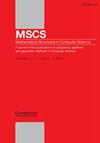两级类型理论及其应用。勘误
IF 0.9
4区 计算机科学
Q4 COMPUTER SCIENCE, THEORY & METHODS
引用次数: 0
摘要
我们定义并发展了两级类型理论(2LTT),这是Martin-Löf类型理论的一个版本,它结合了两种不同的类型理论。我们把它们称为“内”型理论和“外”型理论。在我们感兴趣的情况下,内部理论是同伦类型理论(HoTT),它可以包括一元宇宙和更高的归纳类型。外部理论是验证身份证明唯一性的类型论的传统形式。一种观点认为它是内在类型理论的内化元理论。2LTT有两个动机。首先,关于HoTT有一些元理论性质的结果,例如对于任何外部固定的自然数n,可以在HoTT中构造到n级的半简单类型。这些结果不能在HoTT本身中表示,但它们可以在2LTT中形式化并证明,其中n将是外部理论中的一个变量。这种观点的灵感来自于对预层模型保守性的观察。其次,2LTT是一个框架,它适合于表述人们可能想要添加到HoTT的附加公理。这个想法很大程度上受到了Voevodsky的同伦类型系统(HTS)的启发,它构成了2LTT的一个特定实例。HTS有一个公理,确保自然数的类型表现得像外部自然数,这允许构造一个半简单类型的宇宙。在2LTT中,这个公理可以通过假设内外自然数类型同构来实现。在定义了2LTT之后,我们设置了一组工具,目标是使2LTT成为未来开发的方便语言。作为第一个这样的应用,我们发展了舒尔曼风格的芦苇图理论。继续这条思路,我们提出$(\infty,1)$ -类别的定义,并给出一些例子。本文章由计算机程序翻译,如有差异,请以英文原文为准。
Two-level type theory and applications - ERRATUM
We define and develop two-level type theory (2LTT), a version of Martin-Löf type theory which combines two different type theories. We refer to them as the ‘inner’ and the ‘outer’ type theory. In our case of interest, the inner theory is homotopy type theory (HoTT) which may include univalent universes and higher inductive types. The outer theory is a traditional form of type theory validating uniqueness of identity proofs (UIP). One point of view on it is as internalised meta-theory of the inner type theory. There are two motivations for 2LTT. Firstly, there are certain results about HoTT which are of meta-theoretic nature, such as the statement that semisimplicial types up to level n can be constructed in HoTT for any externally fixed natural number n. Such results cannot be expressed in HoTT itself, but they can be formalised and proved in 2LTT, where n will be a variable in the outer theory. This point of view is inspired by observations about conservativity of presheaf models. Secondly, 2LTT is a framework which is suitable for formulating additional axioms that one might want to add to HoTT. This idea is heavily inspired by Voevodsky’s Homotopy Type System (HTS), which constitutes one specific instance of a 2LTT. HTS has an axiom ensuring that the type of natural numbers behaves like the external natural numbers, which allows the construction of a universe of semisimplicial types. In 2LTT, this axiom can be assumed by postulating that the inner and outer natural numbers types are isomorphic. After defining 2LTT, we set up a collection of tools with the goal of making 2LTT a convenient language for future developments. As a first such application, we develop the theory of Reedy fibrant diagrams in the style of Shulman. Continuing this line of thought, we suggest a definition of
$(\infty,1)$
-category and give some examples.
求助全文
通过发布文献求助,成功后即可免费获取论文全文。
去求助
来源期刊

Mathematical Structures in Computer Science
工程技术-计算机:理论方法
CiteScore
1.50
自引率
0.00%
发文量
30
审稿时长
12 months
期刊介绍:
Mathematical Structures in Computer Science is a journal of theoretical computer science which focuses on the application of ideas from the structural side of mathematics and mathematical logic to computer science. The journal aims to bridge the gap between theoretical contributions and software design, publishing original papers of a high standard and broad surveys with original perspectives in all areas of computing, provided that ideas or results from logic, algebra, geometry, category theory or other areas of logic and mathematics form a basis for the work. The journal welcomes applications to computing based on the use of specific mathematical structures (e.g. topological and order-theoretic structures) as well as on proof-theoretic notions or results.
 求助内容:
求助内容: 应助结果提醒方式:
应助结果提醒方式:


